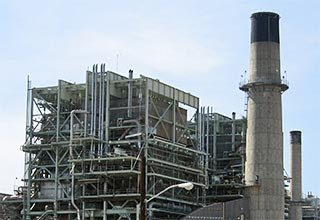 A number of proposals for Liquified Natural Gas (LNG) terminals along the southern California coast are being promoted, citing increasing demand for gas. Because natural gas is the cleanest-burning fossil fuel — in both CO2 and other air pollutants — it has been favored to displace coal and oil for generating electricity and diesel in large vehicles like transit buses.
A number of proposals for Liquified Natural Gas (LNG) terminals along the southern California coast are being promoted, citing increasing demand for gas. Because natural gas is the cleanest-burning fossil fuel — in both CO2 and other air pollutants — it has been favored to displace coal and oil for generating electricity and diesel in large vehicles like transit buses.
To ship natural gas across the ocean it is liquified by chilling to minus 259 degrees Fahrenheit, stored in special tanker ships (photo), shipped, and re-gasified at a receiving terminal. See the California Energy Commission for an LNG overview.
There are serious questions, however, about the safety and emissions of LNG terminals:
- A proposed terminal in the Port of Long Beach was voted down by the Long Beach Board of Harbor Commissioners in January. "Specifically, opponents raised safety concerns, citing the potential for a catastrophic natural gas explosion that could kill hundreds of people and devastate much of the Long Beach waterfront."
- The proposed Cabrillo Port LNG terminal off the Ventura County coast was rejected by the state Lands Commission and the California Coastal Commission in April. It would have emitted "23 million metric tons of carbon dioxide a year, or about 40 percent as much as New York City" as well as "failed to meet local air pollution standards."
- Woodside's OceanWay proposal, "over 20 miles offshore" in Santa Monica Bay, raises similar issues of air pollution and safety near LAX. The LAX area and the ports of Los Angeles and Long Beach are already the largest air polluters in Los Angeles County.
- The energy used to liquify the gas, transport the gas, and regasify it — 15% in one example* — reduces its advantages over other fossil fuels.
There are better alternatives. I find this a critical decision point, whether we invest in more fossil fuel infrastructure that does not reduce global warming, or instead in efficiency and sustainable alternatives that reduce California's greenhouse gas emissions.  Around 50% of California's gas is used to generate electricity. Natural gas demand can thus be directly reduced by:
Around 50% of California's gas is used to generate electricity. Natural gas demand can thus be directly reduced by:
- Replacing old power plants (right) with the most-efficient combined-cycle plants;
- Increasing building energy efficiency in lighting, cooling, and heating;
- Increasing wind and solar electricity generation (especially when combined with smart grid storage with EVs and PHEVs).
Solar thermal hot water systems can also reduce the 10% used to heat residential hot water and swimming pools.
*Julian Darley, High Noon for Natural Gas, p.60.
No comments:
Post a Comment